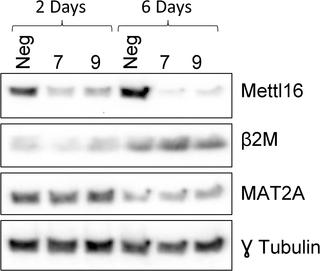Our official English website, www.x-mol.net, welcomes your
feedback! (Note: you will need to create a separate account there.)
Characterization of METTL16 as a cytoplasmic RNA binding protein.
PLOS ONE ( IF 2.9 ) Pub Date : 2020-01-15 , DOI: 10.1371/journal.pone.0227647 Daniel J Nance 1 , Emily R Satterwhite 1 , Brinda Bhaskar 1 , Sway Misra 1 , Kristen R Carraway 1 , Kyle D Mansfield 1
PLOS ONE ( IF 2.9 ) Pub Date : 2020-01-15 , DOI: 10.1371/journal.pone.0227647 Daniel J Nance 1 , Emily R Satterwhite 1 , Brinda Bhaskar 1 , Sway Misra 1 , Kristen R Carraway 1 , Kyle D Mansfield 1
Affiliation

|
mRNA modification by N6-methyladenosine (m6A) is involved in many post-transcriptional regulation processes including mRNA stability, splicing and promotion of translation. Accordingly, the recently identified mRNA methylation complex containing METTL3, METTL14, and WTAP has been the subject of intense study. However, METTL16 (METT10D) has also been identified as an RNA m6A methyltransferase that can methylate both coding and noncoding RNAs, but its biological role remains unclear. While global studies have identified many potential RNA targets of METTL16, only a handful, including the long noncoding RNA MALAT1, the snRNA U6, as well as the mRNA MAT2A have been verified and/or studied to any great extent. In this study we identified/verified METTL16 targets by immunoprecipitation of both endogenous as well as exogenous FLAG-tagged protein. Interestingly, exogenously overexpressed METTL16 differed from the endogenous protein in its relative affinity for RNA targets which prompted us to investigate METTL16's localization within the cell. Surprisingly, biochemical fractionation revealed that a majority of METTL16 protein resides in the cytoplasm of a number of cells. Furthermore, siRNA knockdown of METTL16 resulted in expression changes of a few mRNA targets suggesting that METTL16 may play a role in regulating gene expression. Thus, while METTL16 has been reported to be a nuclear protein, our findings suggest that METTL16 is also a cytoplasmic methyltransferase that may alter its RNA binding preferences depending on its cellular localization. Future studies will seek to confirm differences between cytoplasmic and nuclear RNA targets in addition to exploring the physiological role of METTL16 through long-term knockdown.
中文翻译:

METTL16 作为细胞质 RNA 结合蛋白的表征。
N6-甲基腺苷 (m6A) 对 mRNA 的修饰涉及许多转录后调控过程,包括 mRNA 稳定性、剪接和翻译促进。因此,最近发现的含有 METTL3、METTL14 和 WTAP 的 mRNA 甲基化复合物一直是深入研究的主题。然而,METTL16 (METT10D) 也被鉴定为一种 RNA m6A 甲基转移酶,可以甲基化编码和非编码 RNA,但其生物学作用尚不清楚。虽然全球研究已经确定了 METTL16 的许多潜在 RNA 靶点,但只有少数几个,包括长非编码 RNA MALAT1、snRNA U6 以及 mRNA MAT2A 得到了大量验证和/或研究。在这项研究中,我们通过内源性和外源性 FLAG 标记蛋白的免疫沉淀识别/验证了 METTL16 目标。有趣的是,外源性过表达的 METTL16 与内源性蛋白质的不同之处在于其对 RNA 靶标的相对亲和力,这促使我们研究 METTL16 在细胞内的定位。令人惊讶的是,生化分级显示大部分 METTL16 蛋白存在于许多细胞的细胞质中。此外,敲除 METTL16 的 siRNA 导致一些 mRNA 靶标的表达发生变化,表明 METTL16 可能在调节基因表达中发挥作用。因此,虽然据报道 METTL16 是一种核蛋白,但我们的研究结果表明 METTL16 也是一种细胞质甲基转移酶,可能会根据其细胞定位改变其 RNA 结合偏好。
更新日期:2020-01-16
中文翻译:

METTL16 作为细胞质 RNA 结合蛋白的表征。
N6-甲基腺苷 (m6A) 对 mRNA 的修饰涉及许多转录后调控过程,包括 mRNA 稳定性、剪接和翻译促进。因此,最近发现的含有 METTL3、METTL14 和 WTAP 的 mRNA 甲基化复合物一直是深入研究的主题。然而,METTL16 (METT10D) 也被鉴定为一种 RNA m6A 甲基转移酶,可以甲基化编码和非编码 RNA,但其生物学作用尚不清楚。虽然全球研究已经确定了 METTL16 的许多潜在 RNA 靶点,但只有少数几个,包括长非编码 RNA MALAT1、snRNA U6 以及 mRNA MAT2A 得到了大量验证和/或研究。在这项研究中,我们通过内源性和外源性 FLAG 标记蛋白的免疫沉淀识别/验证了 METTL16 目标。有趣的是,外源性过表达的 METTL16 与内源性蛋白质的不同之处在于其对 RNA 靶标的相对亲和力,这促使我们研究 METTL16 在细胞内的定位。令人惊讶的是,生化分级显示大部分 METTL16 蛋白存在于许多细胞的细胞质中。此外,敲除 METTL16 的 siRNA 导致一些 mRNA 靶标的表达发生变化,表明 METTL16 可能在调节基因表达中发挥作用。因此,虽然据报道 METTL16 是一种核蛋白,但我们的研究结果表明 METTL16 也是一种细胞质甲基转移酶,可能会根据其细胞定位改变其 RNA 结合偏好。









































 京公网安备 11010802027423号
京公网安备 11010802027423号